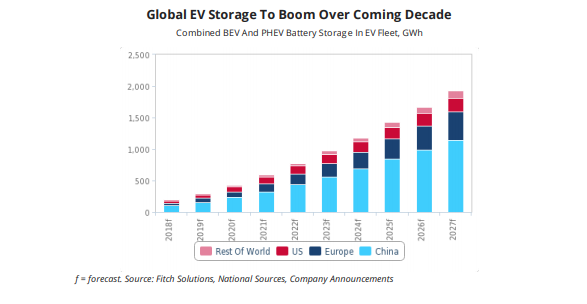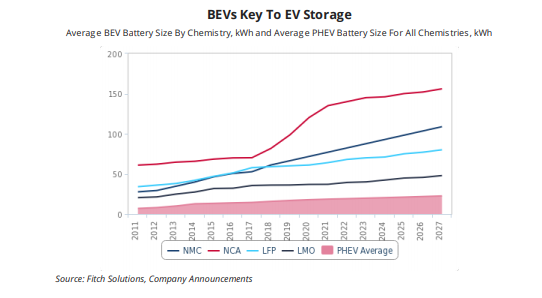The case for electric vehicles (EVs) is getting stronger, as they are seen not only as a cleaner and cheaper means of transportation, but also as a source of battery storage that could step up the integration of intermittent wind and solar generation.
According to a report by Fitch Solutions Macro Research – a unit of Fitch Group – EVs will be the largest source of battery storage over the coming decade in key renewables markets.
The report paints a bright picture for EV uptake, noting that leveraging a two-way flow of electricity from electric vehicles to balance power supply and demand could become a key component of global efforts to introduce renewables to the power mix.
According to Fitch, wind and solar will be the key drivers of renewables growth over the next decade – with the sectors making up 51% and 28% of renewables generation in 2027, respectively. However by that date, the study's authors predict, non-hydro renewables will still only comprise around 13% of the power mix, up from 9% this year.
These figures could be boosted by EV battery storage, which could reduce reliance on carbon emitting baseload and peak power generation plants.
Uptake forecast
Fitch forecasts the EV fleet will number 25 million vehicles by 2027, of which battery electric vehicles (BEVs) will make up 17 million and plug-in-hybrids (PHEVs) 8 million.
As illustrated in the chart below, BEVs feature much larger batteries, ensuring they will make the greatest impact on the global storage market.

By comparison, Bloomberg says EV sales will increase from a record 1.1 million worldwide last year to 11 million in 2025, and will then surge to 30 million in 2030, as EVs establish a cost advantage over internal combustion engine cars.
According to Fitch's forecasts, that will mean 1,931 GWh of storage capacity in the global EV fleet by 2027, with BEVs making up 90% – 1,747 GWh.

V2G benefits
The storage capacity boom will in turn open up substantial opportunities for absorbing renewables generation excesses and releasing this electricity when demand outstrips generation – through vehicle-to-grid (V2G) technology.
The two-way flow of electricity from electric vehicle batteries would enable power systems to rely more on intermittent renewables than currently, Fitch notes.
According to the study's authors, the key precondition to unlocking V2G opportunities will be well established charging networks ensuring EVs stay connected to the grid when not on the road.
The growth of the charging infrastructure market is robust. According to a forecast by GTM Research – now Wood Mackenzie Power and Renewables – the EV charging landscape will comprise up to 40 million public and private charging points by 2030, as electric vehicles are expected to make up 11% of new car sales, up from around 3% today.
Against the backdrop of renewables sector growth and EV fleet expansion, Fitch concludes the report with a message that facilitating V2G will become a pressing priority of EV and power market stakeholders.
This content is protected by copyright and may not be reused. If you want to cooperate with us and would like to reuse some of our content, please contact: editors@pv-magazine.com.




Your article says:
“According to Fitch, wind and solar will be the key drivers of renewables growth over the next decade – with the sectors making up 51% and 28% of renewables generation in 2027, respectively. However by that date, the study’s authors predict, non-hydro renewables will still only comprise around 13% of the power mix, up from 9% this year.”
I don’t see how the increase of non-hydro renewables could be that small, only 4% of supply, over the next nine years.